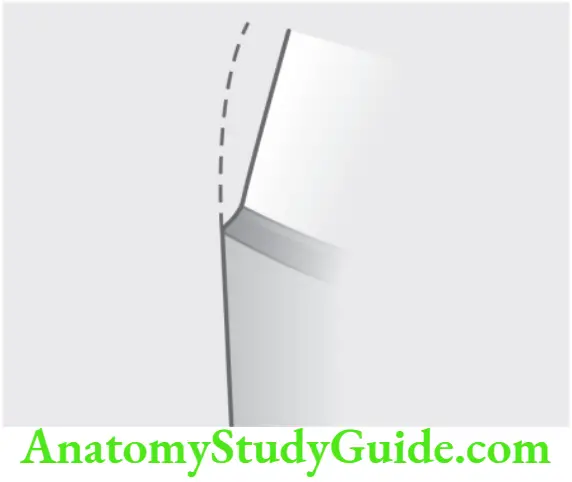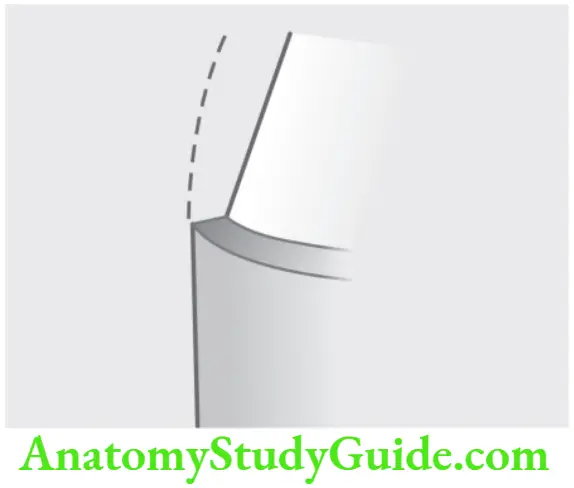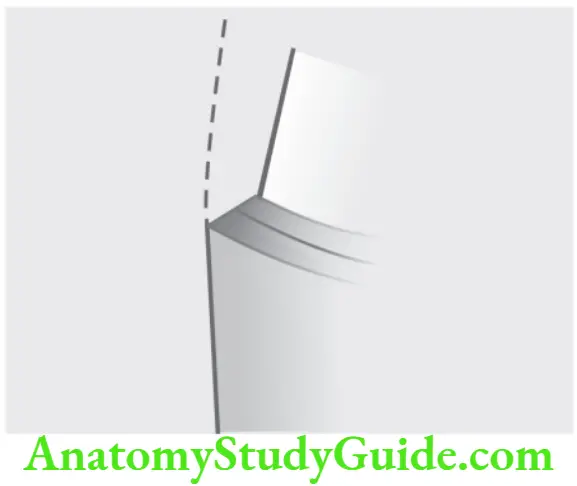Finish Lines In Tooth Preparation – Indications, Advantages, And Disadvantages
Classify Finish Lines. Enumerate the functions, indications, advantages, and disadvantages of finish lines. Add a note on the selection of the type of finish line to be used.
Definition Finish line/margin
The finish line/margin is part of tooth preparation/restoration that is in close proximity to the periodontium and that forms the most important and weakest links in the success of full-coverage restorations.
It is the outer edge of a crown, inlay, onlay, or other restoration.
Read And Learn More: Fixed Partial Denture Short Essay Question And Answers
Other names
Finish line, finish curve.
It is a line of demarcation, a peripheral extension of tooth preparation, and a planned junction of restoration.
Finish Lines In Tooth Preparation
Classification Of Gingival Finish Lines
Gingival Finish Lines Basic types
- Knife-edge/Chisel-edge/Shoulderless cervical finish line.
- Chamfer.
- Shoulder.
Gingival Finish Lines Variations
Variation in knife-edge/Chisel-edge/Shoulder cervical finish line
- Feather edge.
Variations in chamfer
- Hybrid
- Ski-sloped
- Round shoulder
- Heavy chamfer
- McEwen’s chamferette.
Variations in shoulder
- Full shoulder with bevel
- Full shoulder with bevel and butt joint
- Radial shoulder.
Finish Lines In Tooth Preparation
Functions of Finish Lines
- Helps in evaluating the amount of tooth structure removed during tooth preparation
- To evaluate the accuracy of the impression of the tooth preparation
- To evaluate the quality of the die
- To evaluate the marginal adaptation of the wax pattern
- To check the seating of the final restoration
- To evaluate the marginal adaptation of the final restoration.
Characteristics of an ideal finish line have
- Good marginal adaptation
- Biocompatibility with supporting structures
- Adequate contour
- Sufficient strength.
Feather-edge/Chisel-edge Finish Line
Feather-edge/Chisel-edge Finish Line Definition
Knife-edge preparation is a tapered preparation that has maximum tooth reduction at occlusal, and incisal surfaces and tapers to zero cutting at the gingival termination.
Feather Edge Indications
- In young patients
- Pin ledge three-fourth crowns
- In tipped teeth
- In long clinical crowns
- In inaccessible areas in the oral cavity
- When finish lines are on cementum
- As the proximal finish line for inaccessible areas.

Finish Lines Advantages
- Easy to prepare
- Conservative tooth preparation.
Finish Lines Disadvantages
- Location of margin difficult to detect
- Over-contouring of restoration is possible
- Over or under-extended crown due to difficulty in locating the finish line
- Decreased marginal adaptation.
- Decreased retention
- Wedging effect due to internal stresses
- Distortion of the margin is possible during lab procedures as it is thin
- The knife-edge finish line is not a recommended finish line.
Chamfer Finish Line Definition
This is a marginal finish line either curved or formed by a plane at an obtuse angle to the external surface of a prepared tooth (Boucher).
It is a concave extra coronal finish line that possesses greater angulation than knife-edge with less width than the shoulder finish line.
Chamfer Finish Line Instrument used
Round-end tapered diamond.
Chamfer Finish Line Indications
- Ideal gingival finish line for cast-metal restorations
- The lingual finish line for metal-ceramic crowns
- For metal collars.
Chamfer Finish Line Advantages
- Provides a slip joint
- Provides gingival area with acceptable stress distribution, adequate seal, and minimum uniform tooth reduction (El-Ebrashi et al)

- Aids in accurate die trimming
- Can be terminated as subgingival preparation
- Adequate bulk and tooth contour
- Easy to prepare.
Chamfer Finish Line Disadvantages
- Marginal distortion during firing of porcelain
- A reverse lip can form if the entire diameter of the instrument is used
- Less room cervically than shoulder preparation, therefore cannot be prepared with low-speed cutting instrument.
Chamfer Finish Line Variations
Hybrid
- When the chamfer bur is inserted to one-third of the depth of the stone a hybrid preparation results.
It is a preparation between chamfer and knife-edge.
Ski-sloped
- When the chamfer bur is inserted to half the depth of the stone a Ski-sloped preparation results.
Rounded shoulder
- When the entire depth of chamfer bur is used in preparation a rounded shoulder results.
Heavy chamfer
- Used in restorations where more axial reduction is required due to caries or previous restoration. As a heavy chamfer forms a butt joint, the bevel is added to make it a slip joint.
McEwen’s chamfered
- Finish the line between chamfer and feather edge.
Chamfer Finish Line Shoulder Finish Line Definition
- When the external line angle of the preparation is perpendicular to the long axis of the tooth, a shoulder finish line results.
Chamfer Finish Line Instrument used
- Flat-end tapered diamond and flame diamond for gingival bevel.
Shoulder Finish Line Indications
- Facial margins of metal-ceramic preparation
- Preparation margin for all-ceramic restorations
- Margin for castable and injectable ceramics
- 135° shoulder can be used for long clinical crowns.
Shoulder Finish Line Advantages
- Least stress in the cervical area compared to other margins
- Better resistance to occlusal forces
- Bulk of porcelain can be accommodated
- Esthetic

- Easy to identify margin and fabricate wax pattern
- Increased retention
- Good marginal adaptation
- Less marginal distortion
- For proper contouring of restoration with a straight emergence profile
- Easy to check the seating of the restoration.
Shoulder Finish Line Disadvantages
- The least conservative preparation of all the other preparations
- If a metal collar is not used labial porcelain butt fit is more difficult to achieve
- Difficult to prepare
- Can cause adverse pulpal involvement
- Difficult preparation.
Shoulder Finish Line Variations
- Full shoulder with bevel
In erosion of tooth structure, gingival finish line for proximal boxes and for porcelain fused to metal restorations. - Full shoulder with bevel and facial butt joint
The bevel on proximal and lingual surfaces and butt joint on facial surfaces to avoid metal display on the labial side. - Radial shoulder
Shoulder with internal line angle rounded. - Complete shoulders
Finish lines for all-porcelain crowns and injectable ceramic restorations. - Bevelled shoulders
Used for veneers and selected posterior teeth.

- Functions of the bevel:
- Seals restoration against cement leakage and subsequent bacterial invasion
- Easy finishing and burnishing on die or tooth
- Provide circumferential rigidity
- Initiate reproduction of the contour and provide control of the emergence profile during framework try-in.
- Chamfer margin
For posterior crowns and the lingual surface of anterior metal-ceramic crowns. - Knife-edge finish lines
Used for younger patients, pin ledge three-quarter crowns, inaccessible areas of the oral cavity, and finish lines on the cementum.
Principles in Determining Type of Finish Lines
- Type of restorative materials.
- Location of finish lines.
- Configuration.
- Marginal Fit.
Type of Restorative Materials
Gold alloys
- Good burnishability.
- Chamfer margin.
Base-metal alloys
- Lack of perishability
- Chamfer margin.
Porcelain
Shoulder margin.
Metal–ceramic materials
Buccally/labially-shoulder margin and lingually chamfer margin.
Location of finish lines
- Supragingival
- At the crest of gingiva
- Subgingival.
Supragingival Advantages
- Easy to prepare accurately without trauma
- Gingival retraction is not required
- The seating of the restoration can be evaluated
- Can place finish line on enamel
- More biocompatible with surrounding tissues
- Good contour can be achieved
- Easy oral hygiene maintenance
- Easy evaluation of margins during recall
- Can clean luting agent after luting easily.
Subgingival Indications
- Extensive restorations, caries, cervical erosion extending subgingivally
- Proximal contact area extending to gingival crest
- In short clinical crowns
- For esthetics when the labial metal collar needs to be hidden
- In root sensitivity, fracture subgingivally
- When axial contour modification is indicated
- In young patients with high-risk caries
- For additional retention and resistance forms.
Subgingival Disadvantages
- Difficult to access and finish
- Difficult to evaluate fit and cementation procedure
- Periodontal health can be affected if oral hygiene is not maintained.
Finish Lines Configuration
- Ease of preparation without overextension
- Should be able to identify the finish line in the impression and on the die
- A good and clear boundary to which the wax pattern can be finished
- For a wax pattern to be handled without distortion and for the strength of the restoration
- Conservation of tooth structure
- Studies by El-Ebrashi showed that shoulders with rounded internal line angles and chamfer showed less stress concentrations. Shoulder with bevel and featheredge showed the maximum stress concentration.
Finish Lines Marginal Fit
- An ideal marginal fit is smooth and even
- A sliding joint has a better marginal fit.
Mathematical equation (Cosine rule) (Rosner 1963)
- To calculate the marginal gaps
- The closer the hypotenuse of the right triangle approaches the adjacent leg of the triangle, the smaller the gap between the bevel of the wall of the cavity and the casting. This relation is in the un-cemented state
- When a luting agent is used, the fit depends on the film thickness of the luting agent used.
Leave a Reply